Have you ever wondered what “over hard egg” means in cooking? It’s a way to cook eggs where they’re flipped and cooked on both sides. This makes the yolk fully set and the whites cooked through. Knowing this can help you cook your eggs just right.
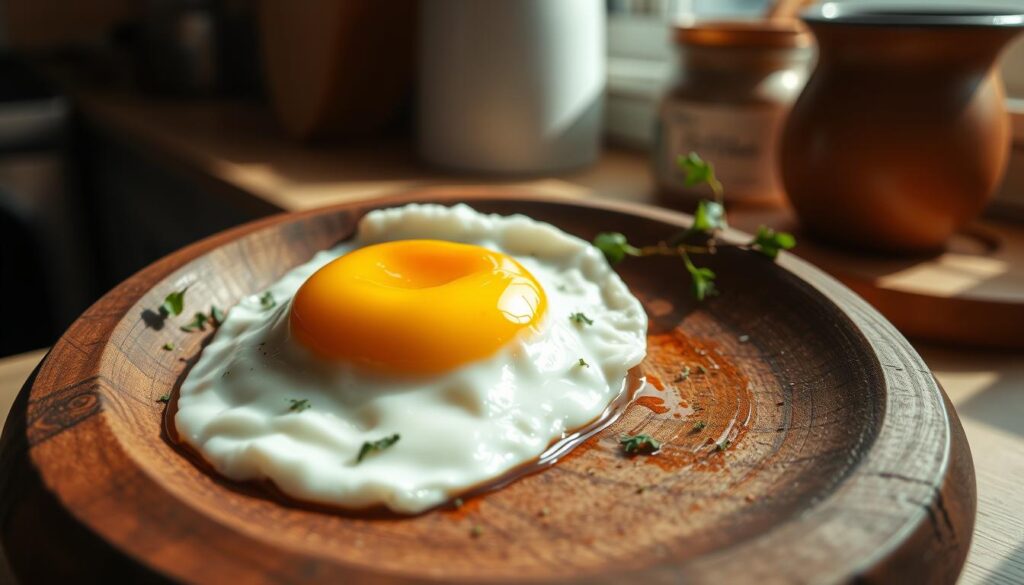
Cooking an over hard egg takes some practice, but it’s worth it. You’ll learn how to make this tasty breakfast at home. In this article, we’ll dive into the world of over hard eggs. You’ll learn how to cook them perfectly.
Key Takeaways
- Understanding what does “over hard egg” mean is essential for cooking eggs to perfection
- Cooking terms like “over hard egg” can help you navigate recipes and cooking techniques
- An over hard egg is cooked on both sides until the yolk is fully set and the whites are cooked through
- Cooking an over hard egg requires skill and practice, but it’s a delicious breakfast food
- Mastering the technique of cooking an over hard egg can help you enjoy this food at home
- Cooking terms and techniques are crucial for achieving the perfect over hard egg
- Learning about over hard egg and cooking terms can enhance your cooking skills and knowledge
Understanding What “Over Hard Egg” Means
An over hard egg is a key term in breakfast cooking. It’s a fried egg that’s cooked on both sides. The yolk is fully set, not runny. People who prefer a firmer yolk and crispy egg white enjoy this style.
Over hard eggs differ from other egg types like over easy or scrambled. Cooking an over hard egg for longer makes the yolk set. This makes for a tasty, filling breakfast that goes well with many foods, like toast or hash browns.
Over hard eggs have a fully set yolk, crispy egg white, and a firm texture. They offer a unique taste and texture that’s great for breakfast. Whether you love traditional breakfasts or want to try something new, over hard eggs are a good choice.
Basic Definition
An over hard egg is a fried egg cooked on both sides. The yolk is fully set, not runny. It’s liked for its firmer yolk and crispy egg white.
Key Characteristics
Some key characteristics of an over hard egg include:
- A fully set yolk
- A crispy egg white
- A cooked texture that is firm to the touch
Comparison with Other Egg Styles
Over hard eggs are different from other egg styles, like over easy or scrambled. To get a perfect over hard egg, cook it longer than an over easy egg. This lets the yolk set fully.
The Science Behind Cooking Over Hard Eggs
Cooking over hard eggs involves more than just heat. It’s about controlling chemical reactions during egg preparation. The right temperature, timing, and technique are key. Mastering these ensures your eggs are always perfect.
Temperature is crucial when cooking eggs. The ideal range is 160°F to 180°F. This helps the whites set and the yolks cook just right. Controlling temperature is essential for how to cook eggs.
Here are some key factors to consider when cooking over hard eggs:
- Use a non-stick pan to prevent the eggs from sticking and to make flipping easier
- Crack the eggs gently to avoid breaking the yolks
- Cook the eggs over medium heat to prevent the bottoms from burning
By following these tips and understanding the science, you can make delicious eggs every time. Whether you’re new or experienced, mastering
Remember, practice makes perfect. Don’t get discouraged if your first tries don’t work out. With time, you’ll get better at making perfect eggs. And don’t be afraid to try new things – it’s all part of learning.
Essential Equipment for Perfect Over Hard Eggs
To get perfect over hard eggs, you need the right tools. The right equipment makes a big difference in egg cooking. A good non-stick pan is key for cooking fried eggs without them sticking.
Here are some key pieces of equipment you’ll need:
- A non-stick pan or a cast-iron skillet: These pans are great for over hard eggs. They heat evenly and prevent eggs from sticking.
- A spatula: You’ll need a spatula to gently flip and remove eggs from the pan.
- Tongs: Tongs are handy for handling eggs, especially when cooking multiple eggs at once.
There are also tools that can improve your egg cooking. An egg ring helps cook perfectly round fried eggs. A cooking thermometer ensures your pan is at the right temperature.
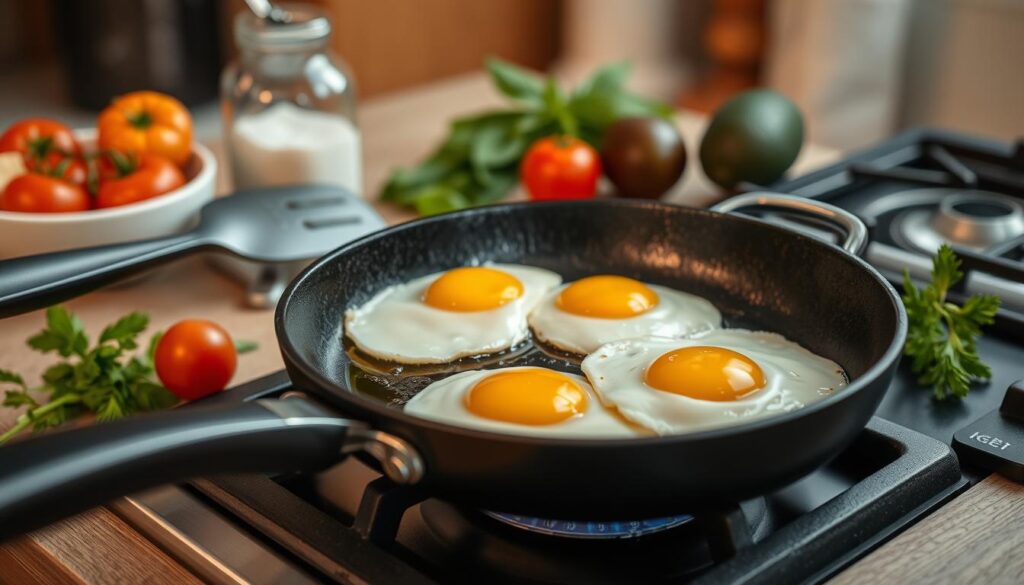
Investing in the right equipment and techniques will help you make perfect over hard eggs every time. Whether you’re new to cooking or experienced, the right tools can greatly improve your dishes.
| Equipment | Description |
|---|---|
| Non-stick pan | Ideal for cooking over hard eggs without sticking |
| Cast-iron skillet | Distributes heat evenly and prevents sticking |
| Spatula | Necessary for flipping and removing eggs from the pan |
Step-by-Step Guide to Cooking Over Hard Eggs
To cook over hard eggs, follow a few simple steps. First, crack the eggs gently into a hot pan with a little oil or butter. This step is key in egg preparation to prevent eggs from breaking and makes flipping easier.
Next, heat the pan to the right temperature, usually medium-low. Use a thermometer to check if the pan is at a safe cooking temperature. This is vital for how to cook eggs just right.
Here are the steps to follow:
- Crack the eggs into the pan and cook for about 2-3 minutes, until the whites are set.
- Flip the eggs over and cook for another 2-3 minutes, until the yolks are fully set and the eggs are cooked to your desired level of doneness.
- Remove the eggs from the pan and serve hot.
By following these simple steps, you can make perfect over hard eggs every time. Always use fresh eggs and cook at a safe temperature for food safety.
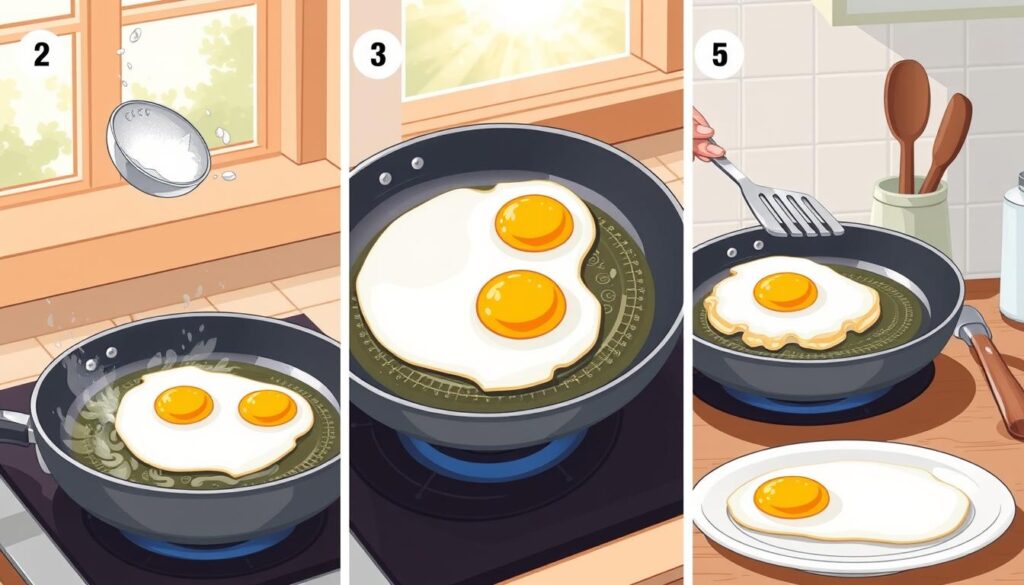
With a little practice, you’ll be great at cooking over hard eggs. Just remember to watch the heat and not overcook the eggs. Overcooking can make them dry and rubbery. Happy cooking!
| Egg Cooking Method | Cooking Time | Temperature |
|---|---|---|
| Over Hard | 4-6 minutes | Medium-low heat |
Common Mistakes When Making Over Hard Eggs
When cooking an over hard egg, mistakes can happen. These mistakes can change how the egg turns out. The key is to know what to avoid. Temperature is very important because it affects the egg’s texture and doneness.
Using the right temperature is crucial. If the heat is too high, the egg can become rubbery. If it’s too low, the egg might not cook right. To fix this, use medium-low heat. This ensures the egg cooks perfectly, making it great for breakfast.
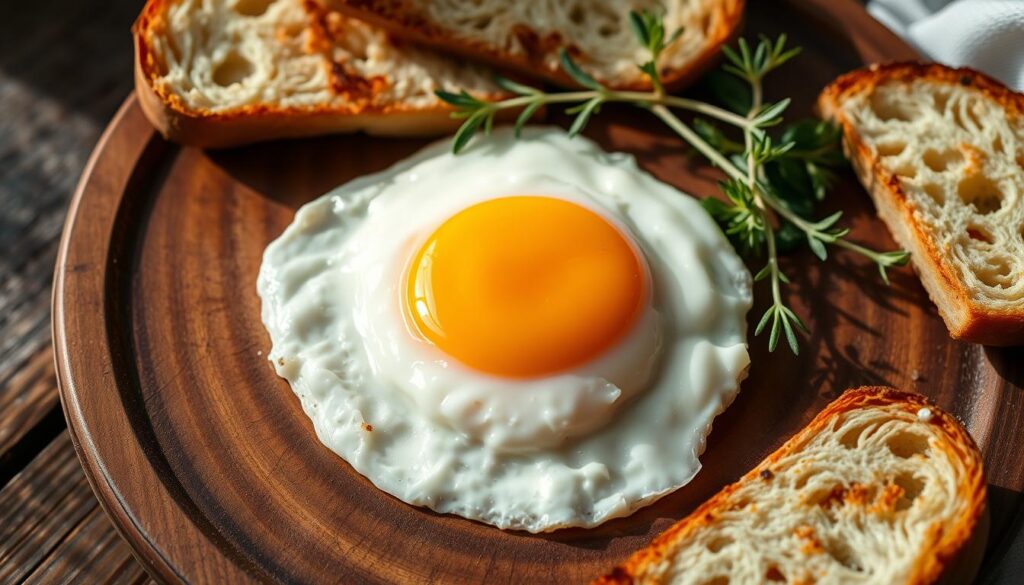
Timing is another issue. Cooking the eggs for too long can make them dry. To avoid this, use a timer. Also, when flipping the eggs, do it gently to keep the yolks whole. By following these tips, you can make a perfect over hard egg for breakfast.
Temperature Issues
- Using too high heat can result in a rubbery texture
- Using too low heat can lead to an undercooked or overcooked egg
- Medium-low heat is recommended for cooking over hard eggs
Timing Problems
- Cooking over hard eggs for too long can result in overcooked and dry eggs
- Using a timer can help achieve the desired doneness
Flipping Techniques
- Flipping the eggs gently can help avoid breaking the yolks
- Using a spatula can help flip the eggs safely and efficiently
| Mistake | Effect | Solution |
|---|---|---|
| Temperature issues | Rubbery texture or undercooked egg | Use medium-low heat |
| Timing problems | Overcooked and dry eggs | Use a timer |
| Flipping techniques | Broken yolks | Flip the eggs gently |
Health Benefits and Nutritional Value
Understanding the health benefits and nutritional value of eggs is key when exploring egg cooking techniques. Eggs are a great addition to a balanced diet. They offer high protein, vitamins, and minerals. For example, fried eggs are rich in vitamin D, which is good for bones.
A large egg has about 70 calories, 6 grams of protein, and 5 grams of fat. Eggs also have zinc, iron, and copper. They are a nutritious choice for a healthy meal plan. You can try different egg cooking techniques, like boiling, poaching, or making fried eggs.
Here are some key nutritional benefits of eggs:
- High-quality protein to build and repair muscles
- Rich in vitamins and minerals, such as vitamin D, B12, and iron
- Good source of healthy fats, like omega-3 fatty acids
- Low in calories, making them a great addition to a weight loss diet
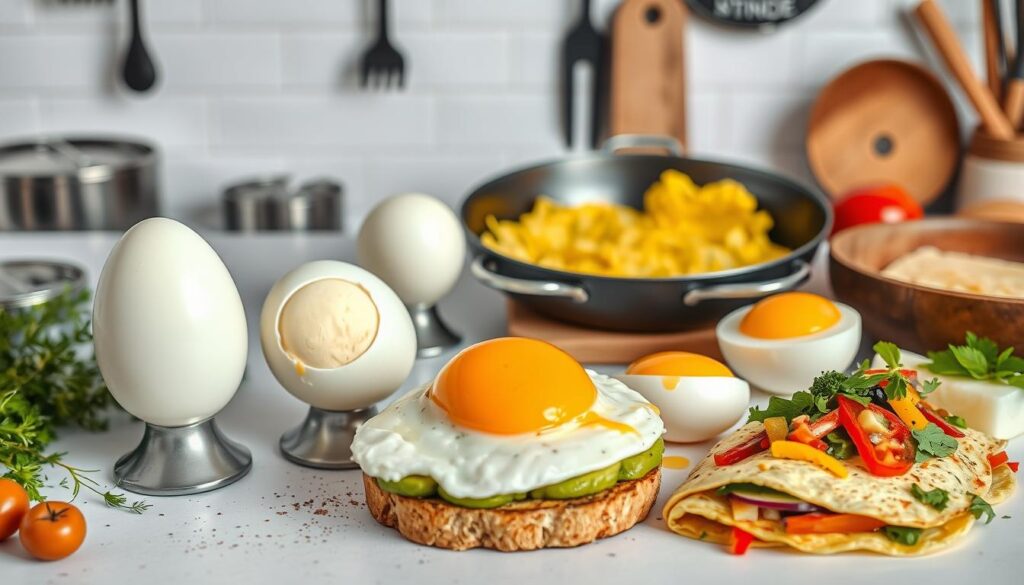
Eggs are a nutritious food that can be part of a healthy diet when eaten in moderation. Knowing the health benefits and nutritional value of eggs helps you make smart choices. You can add them to your meals using various egg cooking techniques, including making tasty fried eggs.
Best Serving Suggestions for Over Hard Eggs
There are many ways to serve over hard eggs. You can have them as a simple breakfast or mix them with other ingredients. Try pairing them with crispy bacon, toasted bread, or hash browns. These are common in breakfast recipes and are easy to make.
For something more, try making eggs benedict or breakfast burritos. These dishes make your over hard eggs look great. You can also try different breads and sauces to add more flavor and texture. The right egg preparation is crucial for a perfect dish.
Here are some ideas to get you started:
- Toast with avocado and cherry tomatoes
- Breakfast tacos with salsa and sour cream
- Eggs benedict with spinach and hollandaise sauce
Exploring different ways to serve over hard eggs can make your meal more exciting. Whether you like classic or creative dishes, the most important thing is to have fun. Try new ingredients and egg preparation methods.
| Serving Suggestion | Ingredients | Flavor Profile |
|---|---|---|
| Eggs Benedict | Poached eggs, ham, English muffins, hollandaise sauce | Rich, savory, slightly sweet |
| Breakfast Burrito | Scrambled eggs, chorizo, black beans, salsa, avocado | Spicy, smoky, fresh |
| Toast with Avocado | Toasted bread, mashed avocado, cherry tomatoes, feta cheese | Light, refreshing, creamy |
Tips for Restaurant-Quality Over Hard Eggs
To make restaurant-quality over hard eggs, focus on egg cooking techniques and fresh ingredients. Fresh eggs make a big difference in taste and texture. Also, pay close attention to cooking terms like temperature and timing for perfect eggs.
Temperature control is key, just like chefs use thermometers. This ensures your eggs are safe and the yolk is fully set. Learning this egg cooking technique will help you make great over hard eggs at home.
Here are some tips for the perfect over hard egg:
- Use a non-stick pan to prevent eggs from sticking and make flipping easier.
- Cook eggs over medium heat to avoid burning the bottom before the top is cooked.
- Avoid overflipping eggs to keep them from breaking and losing shape.
By following these tips and mastering egg cooking techniques, you’ll make a dish that’s tasty and looks good. Remember, it takes practice, so don’t get discouraged if it takes a few tries.
With these tips and practice, you’ll soon be making restaurant-quality over hard eggs. These will impress your friends and family. Whether you’re experienced or new to cooking, learning to make over hard eggs is a skill worth developing.
Troubleshooting Your Over Hard Egg Preparation
Learning to cook eggs can sometimes be tricky. Over hard eggs, in particular, can be finicky. But with the right techniques, you can overcome these challenges. The key is finding the right balance between cooking time and heat.
When making fried eggs, use gentle heat. This prevents the eggs from cooking too quickly. It’s all about the balance.
Common problems with over hard eggs include broken yolks, a rubbery texture, and sticking. To fix broken yolks, add a little water to loosen the egg and then flip it gently. For a rubbery texture, adjust your cooking time and heat.
Sticking issues can be avoided by using the right pan and utensils. This makes flipping and removing the eggs easier.
To avoid these problems, focus on your egg preparation techniques. Use a non-stick pan and a spatula to flip the eggs gently. This prevents breaking and sticking.
By mastering these techniques, you’ll make perfectly cooked over hard eggs every time. Your egg preparation skills will greatly improve.
Fixing Common Issues
- Broken yolks: use a little water to loosen the egg
- Rubbery texture: adjust cooking time and heat
- Sticking issues: use the right pan and utensils
Follow these tips and practice your egg preparation skills. You’ll become a pro at cooking over hard eggs in no time. Remember, mastering egg cooking takes time and patience.
With the right techniques and patience, you’ll enjoy perfectly cooked fried eggs soon.
Conclusion: Mastering the Perfect Over Hard Egg
Cooking the perfect “over hard egg” may take some practice. But the joy of getting that golden, runny yolk is worth it. By learning the science, using the right tools, and following a guide, you’ll make great over hard eggs soon.
Patience and trying new things are key to mastering the over hard egg. Don’t hesitate to experiment with heat and ingredients. Soon, you’ll impress everyone with your egg skills.
Enjoy the process of cooking and the joy of a perfectly cooked egg. It’s great on its own or with breakfast or brunch. Mastering this skill will make you happy with every bite.
FAQ
What does “over hard egg” mean?
An “over hard egg” is a fried egg with a fully set yolk. It’s cooked on both sides until the yolk is firm. This means the yolk is no longer runny.
What are the key characteristics of an over hard egg?
An over hard egg has a firm yolk and a set white. It’s cooked on both sides until it’s solid. This makes the yolk hard.
How do over hard eggs differ from other egg preparation styles?
Over hard eggs have a fully cooked yolk. This is different from over easy or sunny-side up eggs, which have a runny yolk. They also differ from scrambled eggs, which are mixed and cooked more.
What is the science behind cooking over hard eggs?
Cooking over hard eggs involves applying heat to the egg. This causes the proteins to denature and solidify. The higher the heat and longer the cooking, the firmer the yolk becomes.
What equipment is needed to cook perfect over hard eggs?
You’ll need a non-stick or cast-iron pan and a spatula for flipping. You might also use egg rings or a thermometer to check the temperature.
What are the steps for cooking over hard eggs?
Crack the eggs into a hot pan. Cook for 2-3 minutes on the first side. Then, flip and cook for another 2-3 minutes until the yolks are set.
What are some common mistakes to avoid when making over hard eggs?
Avoid using the wrong temperature and cooking for too long or too short. Also, don’t flip the eggs too roughly to avoid broken yolks. Focus on temperature, timing, and technique for perfect eggs.
What are the health benefits and nutritional value of over hard eggs?
Over hard eggs are rich in protein, vitamins, and minerals. But, they may have more cholesterol and saturated fat than other egg styles. Eat them in moderation for a balanced diet.
What are some classic pairings and creative serving ideas for over hard eggs?
Over hard eggs go well with bacon, sausage, and toast. Try them in eggs benedict, breakfast burritos, or on avocado toast for something new.
What tips can help achieve restaurant-quality over hard eggs at home?
Use fresh, high-quality ingredients and cook to the right temperature. Present the dish nicely. Good technique and tools can make your eggs taste like they’re from a restaurant.
How can you troubleshoot common issues when cooking over hard eggs?
For broken yolks or rubbery texture, use the right temperature and flip gently. Adding a bit of water can prevent sticking. Adjusting cooking time and technique can solve these problems.
Chicken Recipes:
- Kennedy Fried Chicken Recipe – Could be linked if your article mentions fried chicken or similar comfort foods.
- Kennedy Fried Chicken Menu – This could align well with discussions of grilled meats or dining experiences.
Italian-Inspired Dishes:
- Ground Turkey and Rice Recipes – Great for internal linking if you’re discussing pasta or hearty dishes similar to those served at the Macaroni Grill.
- Smothered Turkey Wings – May relate to similar flavorful meat dishes.

